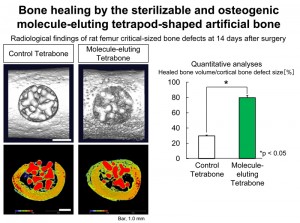Development of sterilizable and osteoinductive artificial bones Bone regeneration by sterilizable calcium phosphate tetrapods eluting osteogenic molecules

Although the clinical success of bone grafts and prosthetic implants has been shown in the treatment of bone defects, graft availability, function, and longevity still remain to be improved. One possible solution for these problems is to develop bone implants acting on host cells to induce rapid bone regeneration.

© Shinsuke Ohba. Osteogenic molecule-loaded Tetrabone was implanted into 2.2 mm-cylinder-shaped bone defects created in femur shafts of 11-week-old rats. Bone regeneration was evaluated by micro-CT. Quantification analysis of the healed bone volume/cortical bone defect size was calculated on micro-CT data. Osteogenic molecule-eluting Tetrabone achieved bone healing in both cancellous and cortical bones.
Dr. Yujiro Maeda (The University of Tokyo Graduate School of Medicine), Project Associate Professor Shinsuke Ohba, and Professor Yuichi Tei/Ung-il Chung (Department of Bioengineering, The University of Tokyo Graduate School of Engineering) demonstrate bone healing with a sterilizable and osteogenic molecule-eluting implant system in which two small molecules, a smoothened agonist (SAG) and a helioxiantin derivative (TH), are loaded onto tetrapod-shaped calcium phosphate granules (Tetrabone). Progenitor cells were directed toward mature osteoblasts with the combinatorial application of the two small molecules acting on different stages of osteogenesis. The loaded SAG and TH were released from Tetrabone for prolonged periods. The osteogenic activity of the SAG- and TH-loaded Tetrabones was not affected by EOG sterilization. The combinatorial use of SAG- and TH-loaded Tetrabones achieved bone healing without cell transplantation in a rat femur bone defect model within two weeks. This system has the advantages of facile manipulation and mass production, leading to a reduction of time and costs in the procedures. Thus, the present study proposes a proof-of-concept of a cell transplantation-free bone regeneration system by helping natural healing abilities of living bodies with a tetrapod-shaped, sterilizable, and osteogenic molecule-eluting artificial bone, contributing to the development of novel strategies for the treatment of bone defects.
Paper
Yujiro Maeda, Hironori Hojo, Nobuyuki Shimohata, Sungin Choi, Kenichi Yamamoto, Tsuyoshi Takato, Ung-il Chung, Shinsuke Ohba,
“Bone healing by sterilizable calcium phosphate tetrapods eluting osteogenic molecules”,
Biomaterials Online Edition: 2013/4/23, doi: 10.1016/j.biomaterials.2013.03.089.
Article link
Links
Graduate School of Engineering
Department of Bioengineering, Graduate School of Engineering
Graduate School of Medicine Skeletal Development and Regeneration Research Group







